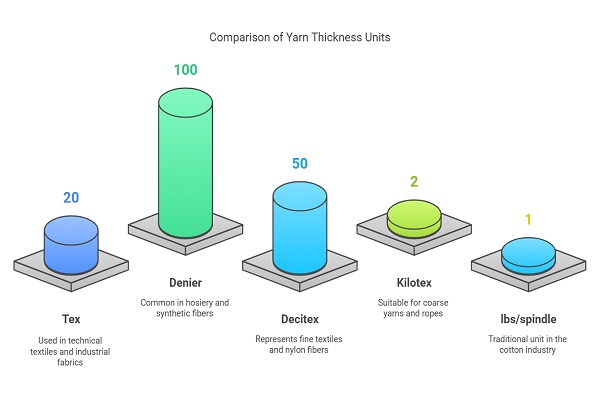Direct Count System Calculator
© Yarn Count Ltd
Disclaimer: All Tools in the Yarn Count have been reviewed by the relevant spinning industry experts.
The formula for Direct Count System
The Direct Count System measures the fineness of yarn based on its weight for a fixed length. The formula varies depending on the unit of measurement:
Formula:
Count=(Weight (grams)÷ Length (meters))×Conversion Factor
Where:
- Weight (grams): The mass of the yarn.
- Length (meters): The length of the yarn.
- Conversion Factor: A unit-specific multiplier used for different count systems.
Conversion Factors:
| Count System | Formula |
| Tex | Weight(g) ÷ Length(m)×1000 |
| Denier | Weight(g) ÷ Length(m)×9000 |
| Decitex (dtex) | Weight(g) ÷ Length(m)×10000 |
| Kilotex | Weight(g) ÷ Length(m) |
| Pounds per Spindle | Weight(g) ÷ Length(m)×0.0625 |
Table of Contents
What is the Direct Count System?
The direct count system expresses yarn thickness as the mass per unit length. Unlike the indirect count system, where higher numbers indicate finer yarns, the direct system follows a straightforward rule: a higher count represents a thicker, heavier yarn, while a lower count indicates a finer, lighter yarn.
This system is primarily used for synthetic fibers and continuous filament yarns because of its accuracy in measuring uniform fibers. It provides a direct way to compare yarn thickness, making it valuable for quality control in textile production.
Common Units in the Direct Count System

The direct count system includes several standardized units used across the textile industry.
1. Tex (T)
- Measures mass in grams per 1,000 meters of yarn.
- A 20 Tex yarn weighs 20 grams per 1,000 meters.
- Commonly used in technical textiles, sewing threads, and industrial fabrics.
2. Denier (D)
- Expresses mass in grams per 9,000 meters of yarn.
- A 100 Denier yarn weighs 100 grams per 9,000 meters.
- Widely used in hosiery, silk, and synthetic fibers.
3. Decitex (dtex)
- Represents mass in grams per 10,000 meters.
- A 50 dtex yarn weighs 50 grams per 10,000 meters.
- Often used in fine textiles, nylon, and polyester fibers.
4. Kilotex (ktex)
- Indicates mass in kilograms per 1,000 meters.
- A 2 Kilotex yarn weighs 2 kilograms per 1,000 meters.
- Suitable for coarse yarns, ropes, and industrial applications.
5. Pounds per Spindle (lbs/spindle)
- A traditional unit measuring mass in pounds per 14,400 yards of yarn.
- Primarily used in the cotton industry.
Conversion Between Units
Textile engineers frequently need to convert between different units. Here are some key conversions:
- Tex to Denier: 1 Tex = 9 Denier
- Denier to Decitex: 1 Denier = 1.111 Decitex
- Tex to Kilotex: 1,000 Tex = 1 Kilotex
- Pounds per Spindle to Tex: 1 Pound per Spindle ≈ 0.5905 Tex
For example, if a yarn has a linear density of 30 Tex, its equivalent in Denier would be:
30×9=270 Denier
These conversions help textile professionals maintain consistency in different measurement systems.
Importance of the Direct Count System

1. Textile Quality Control
The direct count system ensures uniformity in yarn thickness, which is crucial for fabric performance. Accurate yarn measurement prevents inconsistencies in strength, weight, and texture.
2. Yarn Selection for Different Applications
- Apparel fabrics: Finer yarns (lower Tex, Denier) are used for lightweight and breathable textiles.
- Home textiles: Medium-weight yarns suit bed linens, upholstery, and drapery.
- Industrial textiles: Coarser yarns (higher Tex, Kilotex) are required for strong and durable applications like ropes and geotextiles.
3. Cost Efficiency
Using the right yarn thickness minimizes waste and optimizes fabric production costs. Factories rely on accurate yarn measurements to maintain product quality while controlling expenses.
Examples of Direct Count System in Use
Example 1: Choosing Yarn for Sportswear
A manufacturer needs a lightweight, moisture-wicking fiber for sportswear. A 40 Denier yarn is selected because it offers low weight and high flexibility.
Example 2: Selecting Yarn for Industrial Fabrics
A textile company requires strong, durable fabric for making industrial tarps. A 2 Kilotex yarn is used, ensuring high tensile strength and resistance to wear and tear.
Advantages of the Direct Count System
- Straightforward Measurement: Expresses yarn weight in an easy-to-understand format.
- Consistency Across Materials: Works well for synthetic, natural, and blended fibers.
- Versatility: Used in various textile industries, from fashion to industrial manufacturing.
Conclusion
The direct count system is essential for textile engineers and manufacturers. By using units like Tex, Denier, Decitex, Kilotex, and Pounds per Spindle, professionals can make informed decisions for textile production. Understanding these measurements ensures consistent fabric quality, cost efficiency, and suitability for various applications. Mastering this system helps textile experts optimize their manufacturing process and improve product performance.